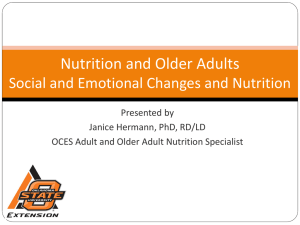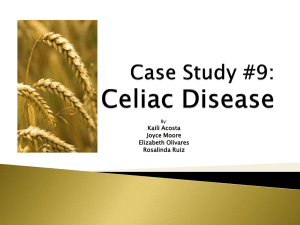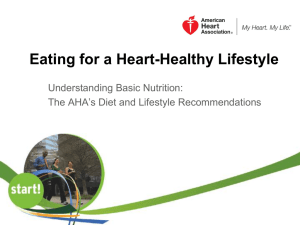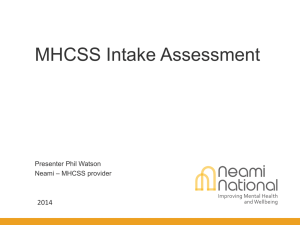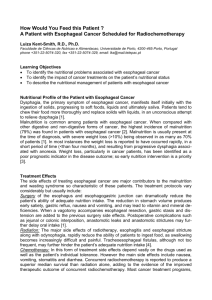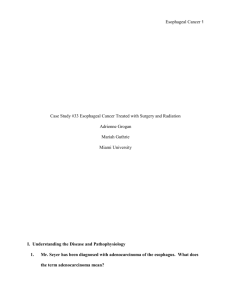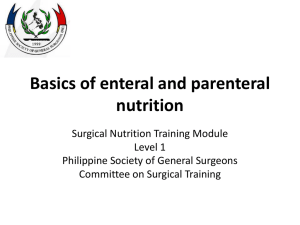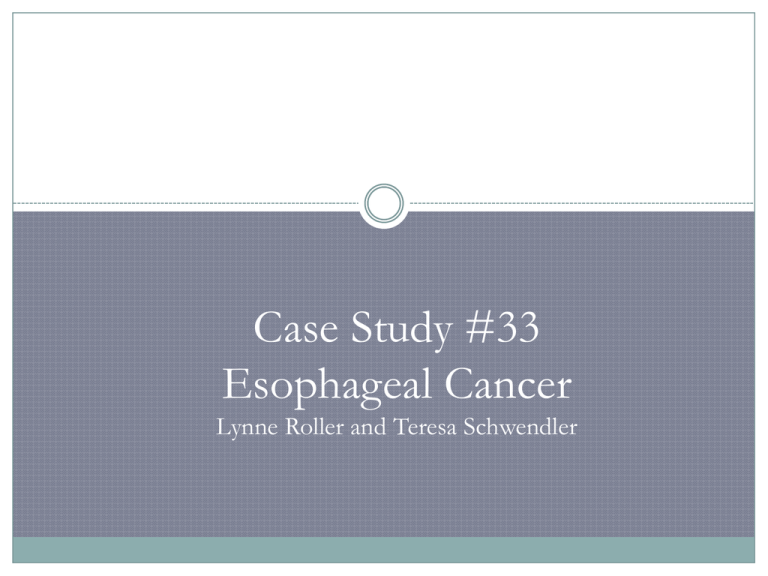
Case Study #33
Esophageal Cancer
Lynne Roller and Teresa Schwendler
What is cancer?
Cancer is a class of diseases characterized by
uncontrolled cell division and the ability of these cells
to invade other tissues-either by direct growth to
adjacent tissue(invasion) or by migration of cells to
distant sites(metastasis)
Esophageal Cancer
Esophageal Cancer
Form 1: Adenocarcinoma (AC)
Form 2: Squamous cell carcinoma(SCC)
Etiology For Esophageal Cancer
Smoking
Alcohol abuse
Obesity
Having bile reflux
Eating few fruits and vegetables
Having gastro-esophageal reflux disease
Being male and between the ages of 45-70
Cancer Identification Procedures
Cytologic test
Physical test
Biochemical test
Description of Patient
●
●
●
●
●
Nick Seyer, 58 y.o. male contractor
Diagnosed with Stage IIB adenocarcinoma of the
esophagus.
Experiencing Dysphagia and Odynophagia
Smokes 2ppd; wife also smokes
Alcohol use: 1-2 drinks 1-2 x/week
Mr. Sayer’s History
•
•
•
•
•
•
•
•
•
•
•
Height: 6’3”
Weight: 198lbs.
BMI: 24.9
%UBW: 87%
Recent weight loss of 30lbs over the past few months
14% weight loss = severe weight loss
Energy Requirements to maintain weight: 1796kcal/day
Energy Requirements to gain weight: 2700kcal/day
Protein Requirements: 135g/day
Fluid Requirements to maintain weight: 1796mL/day
Fluid Requirements to gain weight: 2700mL/day
Mr. Seyer’s Disease measures
Chemistry
Normal Value
Mr. Seyer’s Value
Reason for Abnormality
Nutritional
Implications
Total Protein
6-8
5.7
Inadequate Protein intake
Increase protein intake
Albumin
3.5-5
3.1/3.0
Inadequate protein
intake, dehydration
Increase protein intake,
rehydrate
Prealbumin
16-35
15/12
Inadequate protein intake
Increase protein intake
RBC
4.5-6.2
4.2/4.3
Malabsorption/side effect
of cancer
Increase iron, B12,
folate
Hemoglobin
14-17
13.5/13.9
Low RBC due to cancer
Increase iron, B12,
folate
Hematocrit
40-54
38
Decreased RBC
Increase iron, B12,
folate
Mean cell Hgb
26-32
32.4/32.3
Low RBC
Increase iron, B12
Mr. Sayer’s Diagnosis
Inadequate Protein intake
Inadequate energy intake
Difficulty swallowing
Severe weight loss- Cachexia
Current Treatment
Medical
External Beam Radiation Therapy
Surgery- surgical resection of tumor- transhiatal
esophagectomy
Nutrition
Enteral Nutrition-Isosource HN
Increased calories and protein intake
Esophogectomy
Medical Treatment
Isosource HN
Enteral Formula
kcal/mL: 1.2
Caloric Distribution (% of kcal)
Protein: 18% Carbohydrate: 53%
Fat: 29%
Protein Source: soy protein isolate
NPC:N Ratio: 115:1
MCT:LCT Ratio: 20:80
n6:n3 Ratio: 2.7:1
Osmolality (mOsm/kg water): 490
Water 82%
Enteral Nutrition
Comparison to Mr. Seyer’s Estimated Nutrition Requirements
Value from
I/O chart
Rate of
60.24mL/hr
mL/hr.
Total of
Enteral
1.7 L
Formula for
day
Total
Calories for 2,082 kcal
day
Total
90.1g
Protein
Currently
Receiving
To maintain
weight
(REE with
PAL factor
of 1.3)
To gain weight
(using
30kcals/kg)
75mL/hr
81 mL/hr
94 mL/hr
1.8 L
2L
2.25 L
2,160 kcals
2,335kcals
2,700 kcals
95.4g
103 g
119g
Protein needed
for Cancer
Patient
(1.5g/ kg)
135g
PES
Malnutrition (NI-5.2) related to insufficient enteral nutrition
recommendations as evidence by weight loss of over 30
pounds in a two month period and signs of cachexia
Inadequate protein energy intake (NI-5.7.3) related to
metabolic abnormality due to cancerous state as evidence by
Estimated protein intake higher than recommended
prescribed enteral nutrition therapy.
Goals
Talk with other members of the nutrition care team about
the current amount of enteral nutrition that Mr. Seyer is
receiving . Increase Mr. Seyer’s daily protein intake, via
enteral nutrition, to 135g and increasing calories to
2,700kcals
Intervention
Increase enteral protein intake to 135g per day.
Increase total energy intake to 2700kcal/day in order to
gain weight.
Monitoring and Evaluation
Monitor anthropometrics to track weight gain.
Monitor biochemical data- track protein
Subjective Global Assessment- gauges the patient’s perception
of their ability to accomplish self-care.
True or False?
When people have surgery to remove their cancer they often
also have chemotherapy before to reduce the size of the
tumor and after to treat local areas of reoccurrence?
When people who have cancer start eating again sometimes
they have aversions to eating certain foods?
Enteral nutrition is always suggested for terminally ill cancer
patients?
True or False?
When people have surgery to remove their cancer they often
also have chemotherapy before to reduce the size of the
tumor and after to treat local areas of reoccurrence?(T)
When people who have cancer start eating again sometimes
they have aversions to eating certain foods? (T)
Resources
Jager-Wittenaar, H;Dijkstra PU; Vissink A. “Changes in nutritional status and dietary intake
during and after head and neck cancer treatment.”
http://www.ncbi.nlm.nih.gov/pubmed/20737491
Mayo Clinic (n.d.). Chemotherapy - MayoClinic.com. Retrieved May 5, 2011, from
http://www.mayoclinic.com/health/chemotherapy/MY00536
Mayo Clinic (2011, May). Esophageal cancer: Treatments and drugs - MayoClinic.com, from
http://www.mayoclinic.com/health/esophagealcancer/DS00500/DSECTION=treatments-and-drugs
National Cancer Institute (2012, November 1). When Someone You Love Has Advanced
Cancer - National Cancer Institute. Retrieved from
http://www.cancer.gov/cancertopics/coping/when-someone-you-love-hasadvanced-cancer/page4
National Institutes of Health (2013). Esophageal cancer - National Library of Medicine PubMed Health. Retrieved from
http://www.ncbi.nlm.nih.gov/pubmedhealth/PMH0001328/
Nelms, Marcia; Sucher, Kathryn; Lacey, Karen; Roth, Sara Long. Nutrition Therapy
and Pathophysiology.2/e

